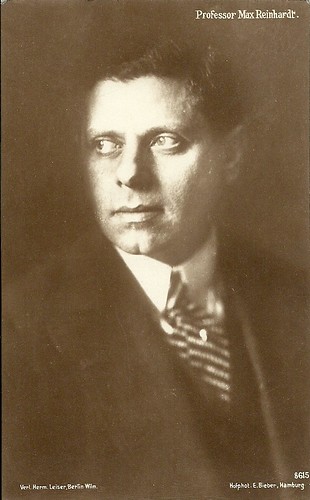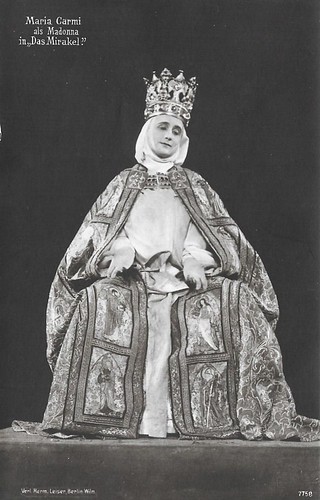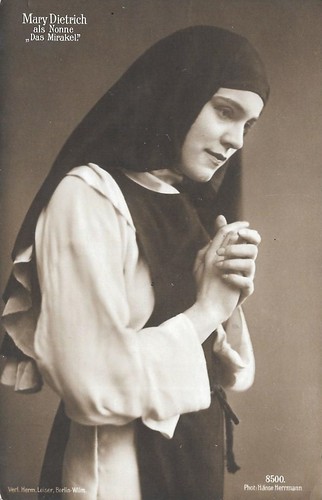In September, we posted 24 rare, recently acquired postcards from the collection of Didier Hanson. Didier keeps sending us wonderful scans. So, today we can post again a dazzling dozen of his a-century-old postcards from Germany and Russia. These include postcards of Das Mirakel/The Miracle (Cherry Kearton, Max Reinhardt, 1912), portraits of the great stage innovators Max Reinhardt and C.S. Stanislavsky, and three cards of Russian silent film diva Vera Karalli.
Image may be NSFW.
Clik here to view.
German postcard. Collection: Didier Hanson.
Anna Pavlova (Russian: Анна Павлова; 1881–1931) was a Russian prima ballerina of the late 19th and the early 20th centuries. She was a principal artist of the Imperial Russian Ballet and the Ballets Russes of Sergei Diaghilev. Pavlova is most recognized for the creation of the role The Dying Swan and, with her own company, became the first ballerina to tour ballet around the world.
Image may be NSFW.
Clik here to view.
German postcard by Verlag Hermann Leiser, Berlin, no. 8615. Photo: Hofphot. E. Bieber, Hamburg. Collection: Didier Hanson.
German actor-director Max Reinhardt (1873-1943) was one of the great innovators of the theatre. He also directed several films, including Sumurûn (1910) and Das Mirakel (1912). In 1934, he went into exile and made in Hollywood A Midsummer Night's Dream (1935).
Image may be NSFW.
Clik here to view.
French postcard, no. R 9. S. Photo: A. Gubtschewsky. C.S. Stanislavsky as Verchinine in the stage production of Les trois soeurs/Three Sisters (Anton Chekhov) by Théâtre Artistique de Moscou (Moscow Art Theatre). Collection: Didier Hanson.
Constantin Sergeievich Stanislavsky (Константи́н Серге́евич Станисла́вский) (1863–1938) was a Russian actor and theatre director. The eponymous Stanislavsky method, or simply 'method acting', has had a pervasive influence on the American theatre and cinema, especially in the period after World War II.
Image may be NSFW.
Clik here to view.
German postcard by Verleih Hermann Leiser, Berlin-Wilmersdorf, no. 7758. Publicity still for Das Mirakel/The Miracle (Cherry Kearton, Max Reinhardt, 1912). Collection: Didier Hanson.
With her aristocratic air, her severe looks but also her sweet undertones, Italian silent film star and stage actress Maria Carmi(1880-1957) was the cinematic translation of the 19th century Primadonna. Later she became Princess Norina Matchabelli and was co-founder of the perfume company Prince Matchabelli.
Image may be NSFW.
Clik here to view.
German postcard by Verleih Hermann Leiser, Berlin-Wilmersdorf, no. 8634. Photo: Hänse Hermann. Publicity still for Das Mirakel/The Miracle (Cherry Kearton, Max Reinhardt, 1912). Collection: Didier Hanson. Mary Dietrich as the nun.
Image may be NSFW.
Clik here to view.
German postcard by Verleih Hermann Leiser, Berlin-Wilmersdorf, no. 8500. Photo: Hänse Hermann. Publicity still for Das Mirakel/The Miracle (Cherry Kearton, Max Reinhardt, 1912). Collection: Didier Hanson. Mary Dietrich as the nun.
Image may be NSFW.
Clik here to view.
Russian postcard. Collection: Didier Hanson.
Vera Kholodnaya (1893-1919) was the first star of the Russian silent cinema. Only 26, the ‘Queen of Screen’ died of the Spanish flu during the pandemic of 1919. Although she worked only three years for the cinema, she must have made between fifty and hundred short films. The Soviet authorities ordered to destroy many of the Kholodnaya features in 1924, and only five of her films still exist.
Image may be NSFW.
Clik here to view.
Russian postcard. Collection: Didier Hanson. Vera Kholodnaya, Vitold Polonsky and Ossip Runitsch.
Vitold Polonsky (1879-1919) was one of the most popular actors in pre-Revolutionary Russian cinema.
Image may be NSFW.
Clik here to view.
Russian postcard. Collection: Didier Hanson.
Russian actor, producer and stage director Ossip Runitsch (1889-1947) was one of the first idols of the Russian silent cinema.
Image may be NSFW.
Clik here to view.![Vera Karalli]()
Russian postcard, 1916. Collection: Didier Hanson.
Vera Karalli(1889-1972) was a Russian ballet dancer, choreographer and actress in the early 20th century.
Image may be NSFW.
Clik here to view.![Vera Karalli]()
Russian postcard. Collection: Didier Hanson. Vera Karalli.
Image may be NSFW.
Clik here to view.![Vera Karalli]()
Russian postcard. Collection: Didier Hanson. Vera Karalli.
Thanks again, Didier!
This is a post for Postcard Friendship Friday, hosted by Beth at the The Best Hearts are Crunchy. You can visit her by clicking on the button below.
Image may be NSFW.
Clik here to view.![]()
Image may be NSFW.
Clik here to view.

German postcard. Collection: Didier Hanson.
Anna Pavlova (Russian: Анна Павлова; 1881–1931) was a Russian prima ballerina of the late 19th and the early 20th centuries. She was a principal artist of the Imperial Russian Ballet and the Ballets Russes of Sergei Diaghilev. Pavlova is most recognized for the creation of the role The Dying Swan and, with her own company, became the first ballerina to tour ballet around the world.
Image may be NSFW.
Clik here to view.

German postcard by Verlag Hermann Leiser, Berlin, no. 8615. Photo: Hofphot. E. Bieber, Hamburg. Collection: Didier Hanson.
German actor-director Max Reinhardt (1873-1943) was one of the great innovators of the theatre. He also directed several films, including Sumurûn (1910) and Das Mirakel (1912). In 1934, he went into exile and made in Hollywood A Midsummer Night's Dream (1935).
Image may be NSFW.
Clik here to view.

French postcard, no. R 9. S. Photo: A. Gubtschewsky. C.S. Stanislavsky as Verchinine in the stage production of Les trois soeurs/Three Sisters (Anton Chekhov) by Théâtre Artistique de Moscou (Moscow Art Theatre). Collection: Didier Hanson.
Constantin Sergeievich Stanislavsky (Константи́н Серге́евич Станисла́вский) (1863–1938) was a Russian actor and theatre director. The eponymous Stanislavsky method, or simply 'method acting', has had a pervasive influence on the American theatre and cinema, especially in the period after World War II.
Image may be NSFW.
Clik here to view.

German postcard by Verleih Hermann Leiser, Berlin-Wilmersdorf, no. 7758. Publicity still for Das Mirakel/The Miracle (Cherry Kearton, Max Reinhardt, 1912). Collection: Didier Hanson.
With her aristocratic air, her severe looks but also her sweet undertones, Italian silent film star and stage actress Maria Carmi(1880-1957) was the cinematic translation of the 19th century Primadonna. Later she became Princess Norina Matchabelli and was co-founder of the perfume company Prince Matchabelli.
Image may be NSFW.
Clik here to view.

German postcard by Verleih Hermann Leiser, Berlin-Wilmersdorf, no. 8634. Photo: Hänse Hermann. Publicity still for Das Mirakel/The Miracle (Cherry Kearton, Max Reinhardt, 1912). Collection: Didier Hanson. Mary Dietrich as the nun.
Image may be NSFW.
Clik here to view.

German postcard by Verleih Hermann Leiser, Berlin-Wilmersdorf, no. 8500. Photo: Hänse Hermann. Publicity still for Das Mirakel/The Miracle (Cherry Kearton, Max Reinhardt, 1912). Collection: Didier Hanson. Mary Dietrich as the nun.
Image may be NSFW.
Clik here to view.

Russian postcard. Collection: Didier Hanson.
Vera Kholodnaya (1893-1919) was the first star of the Russian silent cinema. Only 26, the ‘Queen of Screen’ died of the Spanish flu during the pandemic of 1919. Although she worked only three years for the cinema, she must have made between fifty and hundred short films. The Soviet authorities ordered to destroy many of the Kholodnaya features in 1924, and only five of her films still exist.
Image may be NSFW.
Clik here to view.

Russian postcard. Collection: Didier Hanson. Vera Kholodnaya, Vitold Polonsky and Ossip Runitsch.
Vitold Polonsky (1879-1919) was one of the most popular actors in pre-Revolutionary Russian cinema.
Image may be NSFW.
Clik here to view.

Russian postcard. Collection: Didier Hanson.
Russian actor, producer and stage director Ossip Runitsch (1889-1947) was one of the first idols of the Russian silent cinema.
Image may be NSFW.
Clik here to view.

Russian postcard, 1916. Collection: Didier Hanson.
Vera Karalli(1889-1972) was a Russian ballet dancer, choreographer and actress in the early 20th century.
Image may be NSFW.
Clik here to view.

Russian postcard. Collection: Didier Hanson. Vera Karalli.
Image may be NSFW.
Clik here to view.

Russian postcard. Collection: Didier Hanson. Vera Karalli.
Thanks again, Didier!
This is a post for Postcard Friendship Friday, hosted by Beth at the The Best Hearts are Crunchy. You can visit her by clicking on the button below.
Image may be NSFW.
Clik here to view.
